Stay in the know on all smart updates of your favorite topics.
LEVIS: Advanced Light materials for sustainable Electrical Vehicles by Integration of eco-design and circular economy Strategies

The automotive sector is the second largest contributor to CO2 emissions globally. Even though car manufacturers push forward the development of electric vehicles (EVs), the current market penetration is still relatively low. Developing lightweight materials is an essential step to increase EV adaptation since a reduced weight results in improved vehicle efficiency and increased range.
Space for Food: Space technology for sustainable food systems on Earth
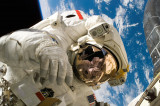
A big part of innovation in space technology revolves around finding smart, efficient and circular ways to establish a life support system for the astronauts going on the trip. Since it’s simply impossible to bring an end-less amount of resources on board, how do you make sure the astronauts can eat, drink and breath?
What if we view “cities as spaceships”; in terms of urban environments being ‘closed-loop systems’? This gives way to the idea that the same space technology developed by ESA could be applied to increase circularity in a city like Amsterdam.
Towards circular resource streams
Municipal wastewater is a great resource for nutrients and water reuse. The Space for Food project aims to use space technology in recovering nutrients and cleaning wastewater that can be used in food production using vertical farming. Closing the loops from waste to resource will help improving the impact in the environment, while creating resilience for the cities.
For this reason, the project will test a proof of concept using a raceway reactor for purple bacteria cultivation on brewery and municipal yellow wastewater at Marineterrein Amsterdam Living Lab. The biomass will be used as slow release fertilizer and bio-stimulant for cultivation of vegetables.
52 weken duurzaam, we gaan het gewoon doen.
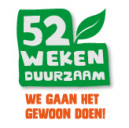
52wekenduurzaam nodigt je uit om je eigen leven stap voor stap duurzamer te maken. Een jaar lang iedere week een kleine verrassende en duurzame stap. Om te zien of het bij je past. Word je er gelukkig van, dan hou je het vol. Zo niet, dan skip je het. Wij onderzoeken wat er wel kan. Uitdagend, leuk, leerzaam en gratis. Loop je een stukje met ons mee?
Wij denken dat we met elkaar op een gemakkelijke manier veel duurzamer kunnen worden. Door elkaar te inspireren en uit te dagen. Door leuke en verrassende dingen te onderzoeken. Om zo je eigen versie van een duurzame leefstijl te ontwikkelen. We streven naar 5000 deelnemers in 2021. Hoe meer mensen meedoen, hoe beter. Voor onze Totale Impact Score, maar ook voor jezelf, want samen is veel leuker dan alleen. Dus geweldig als je nu al je gezin, je buren, vrienden en collega’s inspireert om ook mee te doen.
Responsible Sensing Lab

Smart city systems can help solve urban challenges. But when collecting data, what public values are involved? The Responsible Sensing Lab explores how to integrate social values such as autonomy, privacy, transparency, inclusiveness and empowerment in the design of sensing systems in public space.
In January 2021 the Responsible Sensing Lab was officially launched during an interactive livestream event. In essence the Lab is a testbed for conducting rigorous, transparent, and replicable research on how our smart technologies placed in public space can be designed in a way that makes the smart city ‘responsible’. Responsible Sensing Lab is a collaboration between the City of Amsterdam and AMS Institute.
A lab for a ‘responsible’ smart city
The City of Amsterdam has many smart technologies in place: from smart devices that measure things (i.e. sensors) to smart devices that steer processes in the city (i.e. actuators) such as traffic lights, charging stations, adaptable street lights, barriers that go up and down, and adaptive digital signs.
At the Responsible Sensing Lab we research, develop and integrate smart technologies like the aforementioned to help solve urban challenges. At the same time, we explore how to embed society’s public and democratic values in the design of these innovations.
(Re)designing, prototype testing and implementing responsible sensing systems
Within the Lab academics are invited to connect and work with practitioners who are responsible for digital systems in the city to (re)design, prototype and test (more) responsible ways of sensing in public space.
Hence, Responsible Sensing Lab is a place where teams of multi-disciplinary stakeholders – such as computer scientists, policy makers, psychologists, designers and hardware experts – can address existing hardware, software and other city sensing systems.
Core values
At the Responsible Sensing Lab, we use the City’s values (TADA, Digital City Agenda) as our starting point. We explore what these values mean when applied to actual software, hardware, user-experience design and governance.
Also, we are inspired by the methodology of value sensitive design. This approach allows us to focus on design choices inherent in the type of sensing hardware, the distribution of intelligence between cloud and back-end, the physical design and placement of sensors in public space, and interaction possibilities for citizens.
Do you want to know more or are you looking to collaborate? Contact us via our website!
Communication Alliance for a Circular Region (CACR)

De taskforce Communication Alliance for a Circular Region (CACR) wil de circulaire economie in de Metropoolregio Amsterdam versnellen met praktische verhalen voor en over ondernemers en bedrijven. We nodigen iedereen uit mee te doen met de discussie op amsterdamsmartcity.com. De CACR bestaat uit: Hogeschool van Amsterdam | Gemeente Amsterdam | Amsterdam Economic Board | Amsterdam Smart City | Metabolic en AMS Institute.
Artikelen 'Circulaire economie en data'
• Volop kansen in de nieuwe circulaire werkelijkheid / Data zijn de zuurstof van de circulaire economie: deel 1
• Slim datagebruik in de circulaire economie: de drie belangrijkste redenen / Data zijn de zuurstof van de circulaire economie: deel 2
• 100.000 bedrijven restafvalvrij in 2025
• Slim datagebruik in de circulaire economie: dit is wat bedrijven zelf kunnen doen / Data zijn de zuurstof van de circulaire economie: deel 3
Artikelen circular strategies
Maak je bedrijf toekomstbestendig met deze circulaire strategieën
--------------------------------------------------------------------------------
The taskforce Communication Alliance for a Circular Region (CACR) is working to accelerate the circular economy in the Amsterdam Metropolitan Area, sharing practical stories for and about entrepreneurs and businesses. The CACR is an initiative by Amsterdam University of Applied Sciences | City of Amsterdam | Amsterdam Economic Board | Amsterdam Smart City | Metabolic | AMS Institute.
Articles 'Circular economy and data'
• A wealth of opportunities in the new circular reality / Data is the oxygen that the circular economy thrives on: part 1
• Smart data usage in the circular economy: 3 key reasons / Data is the oxygen that the circular economy thrives on: part 2
• 100,000 companies residual waste-free by 2025
• Smart data use in the circular economy: this is what companies can do themselves / Data is the oxygen that the circular economy thrives on: part 3
Articles: Future-proof your business using circular strategies
Operationeel Mobiliteitscentrum (OMC)

In de toekomst zullen we ons anders door de stad moeten bewegen. Vanwege de toenemende drukte en de verduurzamingsopgave zullen we minder afhankelijk moeten worden van onze privéauto. Dit betekent meer fietsen, meer met het openbaar vervoer en meer gebruik van nieuwe vormen van vervoer zoals deelmobiliteit. Om deze mobiliteitstransitie te kunnen faciliteren moet de gemeente ook haar rol als wegbeheerder herzien. De huidige verkeerscentrale is namelijk nog vooral gericht op klassiek wegverkeer en kijkt dus niet naar de verschillende mobiliteitsstromen. Daarom testen we in Amsterdam Zuidoost met een nieuwe mobiliteitscentrale die naar alle verschillende mobiliteitsstromen kijkt.
Wicked Problems
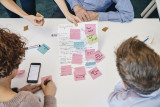
Te wicked? Niet voor ons.
Wij werken allemaal aan urgente, complexe, maatschappelijke uitdagingen. Issues die schier onoplosbaar lijken, van dilemma’s en paradoxen omgeven, nog niet duidelijk hoe het moet. Wel is duidelijk dát het moet, dat we elkaar nodig
hebben en dat we er NU aan moeten beginnen. Om met de woorden van Jan Rotmans te spreken; we leven niet in een tijdperk van verandering maar in een verandering van tijdperk. En hier hoort een nieuwe gereedschapskist bij.
En of je nou aan energietransitie werkt, andere mobiliteitssystemen, creëren van waterstofhubs, peer to peer autodeelsystemen, het maakt niet uit, we zien dat al deze opgaven op enig moment tegen gelijksoortige barrières aanlopen. Op samenwerking, financiering, privacy, onvoldoende aansluiting op de maatschappij, om maar een paar voorbeelden te noemen.
Unieke samenwerking
Als Amsterdam Smart City netwerk willen en kunnen we deze opgaven niet laten liggen. Door het bundelen van onze kennis en expertise kunnen we als netwerk iets unieks bieden en de wil en durf tonen om deze barrières te doorbreken. De betrokken partners die dit uitdenken en begeleiden zijn RHDHV, Kennisland, Drift, NEMO, Arcadis, Alliander, HvA en Metabolic. Zij bundelen hun expertise en ervaring om de echte vragen boven tafel te krijgen, tot nieuwe manieren van samenwerken te komen en barrières te doorbreken. We richten ons met name op de start van de samenwerking. Gezamenlijk ontwikkelen we een ‘wicked problem aanpak’. Op een nieuwe manier, lerend door te doen, exploratief.
Waar moet je aan denken?
Wat is eigenlijk het echte probleem? Wiens probleem is dit? Hoe kijken anderen er tegenaan? Welke andere partijen lijken nodig? Hoe vind je ze? Hoe ga je om met eigenaarschap en botsende frames? Hoe zorg je dat je al in
een vroeg stadium de maatschappij (bewoners, ondernemers, werknemers, etc) betrekt en hun ervaringen in het project trekt? Het wicked problem team zet nieuwe methoden in voor het beantwoorden van deze vragen. En het creëren van de benodigde commitment om het vraagstuk aan te pakken. Niets staat van te voren vast, want we passen ons aan aan wat we tegenkomen. Met elkaar ontwikkelen we een nieuwe aanpak om de barrières te doorbreken.
Isolde de Ridder Sieraden

At Isolde de Ridder Sieraden, founded by Isolde de Ridder – Le Creurer in 2017, creating high-end jewellery with the greatest of care for both people and planet, is our mission. We strive to make the world more beautiful with our unique jewellery. Our unique pieces are crafted by hand in the Netherlands. Jewellery that give discarded metals and other materials a second life and that contribute to a better world for generations to come.
Upcyclecentrum Almere

In the Upcyclecentrum we make the circular economy and the upcycle process visible and tangible. We don’t do this alone. Our residents provide us with raw materials by properly separating their waste, the entrepreneurs (startups) upcycle these raw materials into new products and inspiring workshops are organized in our circular designed experience center. Waste = raw material in the circular economy; this is the central theme of all our activities.
Follow us on instagram on www.instagram.com/upcyclecentrum
#upcyclecentrum
3-CYCLE
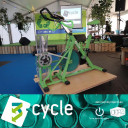
We are 3-CYCLE, a new upcycling project by Erik Fakkeldij (The Botfactory) and Joost Bosker (Oerz). We joint forces in 2019 to create new products from used pieces of plastics and metal. And... to make this a true dutch innovation, we use a setup with a bike to do the first steps of the upcycling process!
But that's not all... we do this by giving workshops and presentations to kids and the public to create more awareness. Our aim is to show that waste is not only bad for the environment, but it also means missed opportunities for reusing the waste and upcycling it into new products.
We believe this type of education is key for engaging the public, while making a
difference at the same time.
Unravelau

Unravelau is a high-end fashion brand established in 2017 by the designer Laura Meijering who believes that you don’t have to sacrifice style in order to make conscious choices. While each collection is unique, they are all designed with care for the planet. Our garments are handcrafted in The Netherlands and made of natural and upcycled materials only. At Unravelau, we believe that every little step counts - together with you, we unravel the fashion industry. One garment at a time.
De energietransitie uitgelegd

De energietransitie is een van de belangrijkste maatschappelijke thema’s van dit moment en van de komende jaren. Maar wat ís de energietransitie? En wat zijn de specifieke doelen? Wat is het verschil tussen ‘energieneutraal’, ‘klimaatneutraal’ en ‘CO₂-neutraal’? Welke rol kan waterstof (niet) gaan spelen in de gebouwde omgeving van de toekomst? En hoe zitten ons huidige energieverbruik en energiesysteem in elkaar? Deze en andere vragen worden beantwoord in het boek ‘De energietransitie uitgelegd’. Ook komt aan de orde waar de uitdagingen liggen voor de energietransitie en hoe het energiesysteem er in 2050 ongeveer uit zal zien.
‘De energietransitie uitgelegd’ biedt alle basiskennis die nodig is om het nieuws omtrent de energietransitie kritisch te kunnen volgen en een gefundeerde mening te vormen in discussies over dit thema. Er is geen specifieke voorkennis nodig om het boek te kunnen lezen, maar het gaat op bepaalde onderwerpen wel diep in. Hierdoor is het boek interessant voor zowel energie-professionals als geïnteresseerde leken.
Nieuwsgierig geworden? Bestel het boek via uw boekhandel, bol.com of door het sturen van een email aan info@degroenewaterlelie.nl. Bij een afname van 10 of meer boeken ontvang je 5% korting (alleen bij bestellingen via email).
Het boek is gedrukt op boomvrij papier. Er zijn alleen bio-inkten gebruikt en er is gewerkt zonder schadelijke oplosmiddelen.
Transition from Smart to Inclusive city

The primary objective of this research project is to enhance an understanding of the concept of inclusion and its criteria in Smart city discourse. The research ambition is applying the result as a tool for benchmarking inclusive smart cities, which can assess and improve them. To apply the result, we aim to work with cities like Amsterdam, The Hauge, and Rotterdam.
Classifying Pathways for Smart City Development: Comparing Design, Governance and Implementation in Amsterdam, Barcelona, Dubai, and Abu Dhabi
The emergence of the Internet of Things (IoT) as the new paradigm of Information and Communication Technology (ICT) and rapid changes in technology and urban needs urge cities around the world towards formulating smart city policies. Nevertheless, policy makers, city planners, and practitioners appear to have quite different expectations from what smart cities can offer them. This has led to the emergence of different types of smart cities and pathways of development. This research aims to answer the research question: When comparing a selection of smart city projects, can we classify pathways for their implementation? We do this by using a cross-case research design of four cities to explore commonalities and differences in development patterns. An input-output (IO) model of smart city development is used to retrieve which design variables are at play and lead to which output. The four cases pertain to the following smart city projects: Smart Dubai, Masdar City, Barcelona Smart City, and Amsterdam Smart City. Our analysis shows that Amsterdam is based on a business-driven approach that puts innovation at its core; for Masdar, technological optimism is the main essence of the pathway; social inclusion is the focus of Barcelona Smart City; and visionary ambitious leadership is the main driver for Smart Dubai. Based on these insights, a classification for smart city development pathways is established. The results of the present study are useful to academic researchers, smart city practitioners, and policy makers.
Input-Output Modelling for Smart City Development

While many national and local governments in the world these days are placing their bets on smart city development in countering challenges , few know exactly how to develop them in practice. A high and rising number of publications has appeared addressing the concept of ‘smart city’, but not many address implementation issues. This paper aims at a conceptual understanding of the smart city by describing its various facets and using them to develop an Input-Output model helping policy makers and analysts make reasoned design choices. Using this model allows policy-makers and analysts to further their conceptual understanding of smart cities, envisage design choices they will face during implementation and understand the effects of these choices. Finally, the model and design variables are illustrated by introducing the case of ‘Smart Dubai’. Overall this paper provides an enhanced understanding of the smart city development process which can be used as a support tool for decision making.
Oceanic Face shields
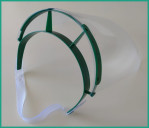
Personal protection products made with high plastic recycling content (all green parts) Other parts still work in progress
OCEAN (and EAR) SAVERS
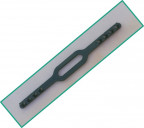
Product made with 100% recycled plastics from the maritime industry (obsolete fishing gear and ropes)
Solar Decathlon Europe
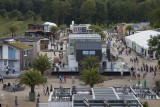
The Call for Cities for the Solar Decathlon Europe 2023 has been published. This would be a huge opportunity for Amsterdam to host this event to raise energy literacy.
Seenons
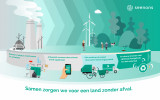
Samen maken wij 100.000 bedrijven restafval-vrij in 2025!
Seenons maakt het omschakelen naar een duurzame bedrijfsvoering gemakkelijk.
Seenons bundelt de krachten van traditionele afvaldienstverleners en duurzame logistieke partijen in een intelligent platform. Jij geeft aan welke specifieke afvalstromen er vrij komen bij jou in het bedrijf. Wij kijken welke partij bij jou in de buurt is en halen het afval op de meest duurzame manier op. Dit gebeurt allemaal contract vrij en is optimaal flexibel opgesteld. Geen vaste dagen met betrekking tot het ophalen. Simpelweg: bak vol? Geef het door, wij regelen de rest!
Op de hoogte blijven van ontwikkelingen of meer informatie?
Stuur een mailtje naar <hallo@seenons.com>
Stay up to date
Get notified about new updates, opportunities or events that match your interests.


